Top 13 for 2013: The Big, The Small and The Unusual
posted Wednesday, December 11, 2013 at 8:04 AM EST
The Imaging Resource 2013 Camera of the Year awards

Best Enthusiast Zoom of 2013
Camera of the Year, Best Enthusiast Zoom: Sony RX10
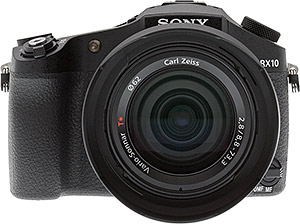
The Sony RX10 offers something truly unique. Compared to its bridge-camera competition, the RX10 is in a different league, thanks to a weather-sealed body and a large 1-inch sensor that brings much better high-ISO performance. Compare it head-to-head with an APS-C DSLR and the RX10 will come surprisingly close in image quality at lower sensitivities, while its bright f/2.8 constant-aperture zoom lens can obviate the need for high ISO shooting. And man, what a lens! You'd need to buy a quiver of lenses for an interchangeable-lens camera to match what the Sony RX10 gives you, spending a small fortune in the process. Unless you love the idea of futzing with interchangeable lenses, the Sony RX10 offers a very compelling alternative to SLR and mirrorless cameras. In the bridge camera world it is without peer.
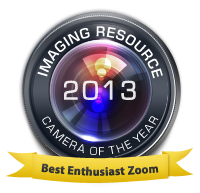
The Sony RX10 is more than just a viable alternative to ILCs and bridge cameras, though: it's also a surprisingly capable video camera, with features not offered even by professional full-frame DSLRs costing thousands of dollars more. Full-sensor readout means that the RX10 is far less prone to moiré and false color than other cameras, DSLRs especially. Manual and priority exposure is possible, and you can choose manual or full-time autofocus with tracking and face recognition. You'll also find microphone and headphone jacks, audio level monitoring and control and even support for XLR mics via an optional accessory. This is an exceptionally hard camera to put in a nutshell, but let's try: if you're into sports, travel, journalism, street shooting, you dislike tiny sensors, noisy photos or video moiré, you care a lot about audio recording in video, or you're not a fan of lugging around lenses just in case you need them, then the Sony RX10 is the camera for you!
Buy now: Adorama | B&H | Amazon
Camera of Distinction, Enthusiast Zoom: Olympus Stylus 1
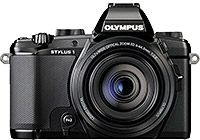
The Olympus Stylus 1 is a rare hybrid: a long-zoom bridge camera that can still fit in a coat or vest pocket. While there are smaller cameras with longer zoom range, none approach the large sensor and fast, sharp glass of the Stylus 1. The 300mm (35mm equivalent) constant f/2.8 lens makes the Stylus 1 special, but when you factor in size and price point, the Stylus 1 stands alone. We were particularly thrilled with the creamy bokeh in our shooting: shallow depth of field like that on the Stylus 1 is rarely seen in a bridge camera.
Buy now: Adorama | B&H | Amazon
Best Pocket Interchangeable Lens Camera of 2013
Camera of the Year, Best Pocket Interchangeable Lens Camera: Panasonic GM1
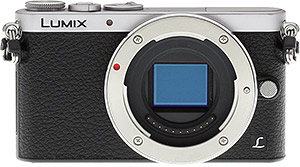
The first truly micro Micro Four Thirds camera! This particular category started as an inside joke at first, but the more we thought about it, the more apt it seemed. Though there have been other diminutive Micro Four Thirds models, the Panasonic GM1 is what we all envisioned with the announcement of the Micro Four Thirds system. If you've yet to hold it yourself, you really must: its size is absolutely astonishing, truly putting it into a class of its own.

The Panasonic GM1 is as impressive in image quality and performance as it is small: the tiny GM1 features the same exceptional sensor, processor and AF capabilities as the larger Panasonic GX7 (itself the winner of our enthusiast mirrorless award)! Autofocus feels near instantaneous on all but very low-contrast subjects and image quality is terrific.
The GM1 with its 12-32mm f/3.5-5.6 kit lens won't fit into your skinny jeans, but it will easily fit in cargo pants and jacket pockets. Want a one-camera-one-lens walk around combo? The GM1 and its 12-32mm kit lens are a sublime pairing. Need to shoot telephoto? Low light? Throw on one of the many terrific Micro Four Thirds lenses.
Buy now: Adorama | B&H | Amazon
Most Unique Products of 2013
Camera of the Year, Most Unique Product: Nikon Df
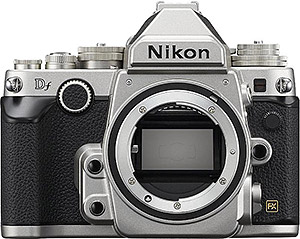
Take a look back over the history of the single-lens reflex camera, and there's a pretty clear trend: External controls -- the knobs, levers and dials all over your camera's body that quickly become second nature to adjust -- have gradually vanished over the years, replaced first in the age of electronics, and then in the digital era, by a handful of buttons and a menu system nested eight layers deep. (Or so it seems.) The Nikon Df spurns that modern aesthetic, teleporting you back to days gone by -- and just about everywhere you touch, there's comfy leatherette instead of cold, impersonal metal and plastic, to boot. One click glance at the top of the Nikon Df, and you can confirm shutter speeds, exposure compensation, and ISO sensitivity -- even when the camera is switched off.
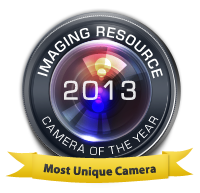
The Nikon Df is more like the film camera you remember through your rose-tinted glasses, except it's digital, and absolutely top-drawer digital at that. It even forgoes movie capture completely, in favor of a more traditional SLR experience. There's a lot more to the Nikon Df than the retro aesthetic, though. It's the smallest and lightest FX-format (full-frame) digital SLR Nikon has ever made. And under the skin, the Nikon Df boasts some seriously professional-grade hardware: exactly the same 16-megapixel image sensor and EXPEED 3 image processor used in 2012's Nikon D4, yet at half the price of that camera at launch. That pairing of old and new, of approachable and professional, makes the Nikon Df a pretty exciting camera, in our book!
Buy now: Adorama | B&H | Amazon
Camera of Distinction, Unique New Product: Sony QX-series
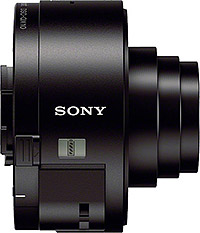
In selecting our Camera of the Year award winners, we hemmed and hawed over Sony's QX-series cameras, and came within a whisper of naming them 2013's Most Unique Product. And they are, without question, unique. We've never seen anything that defies convention quite like the Sony QX-series, nor have we seen any product provoke quite such varied opinion. The Sony QX-series cameras take smartphone photography in a whole new direction, and give your phone access to photo features its makers never dreamed of. The large-sensor Sony QX100 offers the same large sensor and great lens as in the RX100 II (our pocket camera of the year for 2013), and the long-zoom Sony QX10 has a whopping 10x zoom lens akin to that in the WX150 compact. And we understand that both models -- especially the QX100 -- are selling far beyond Sony's own hopes and expectations.
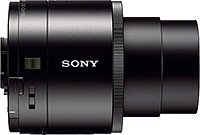
But therein lies the rub: while both are well-received products, neither is really aimed at the dedicated photographer. These are cameras for those whose photography experience revolves not around the camera, but the phone, first and foremost. Important features photographers would expect at this price point -- such as fully-manual exposure and raw shooting -- aren't present, because they don't gel with the smartphone experience. Imaging Resource is a website primarily catering to amateur, enthusiast, and professional photographers, and our awards have that same focus. Much as we wanted to honor the QX-series' unique nature, it didn't feel quite right to do so over products more directly aimed at our own readers. But let that take nothing away from the Sony QX-series: These lens-style cameras are clearly unique, and clearly have great attraction for many smartphone owners. They're also excellent tools for drawing phone-photographers more deeply into the photo hobby, and for that, especially, we salute them. For all these reasons, we recognize the Sony QX-series as 2013 Products of Distinction, as some of the Most Unique Products of 2013.
Buy now - QX100: Adorama | B&H | Amazon | Buy now - QX10: Adorama | B&H | Amazon
Camera of Distinction, Unique New Product: Fujifilm X100S
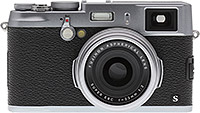
Last year, Fujifilm -- a company known for thinking outside the box when it comes to image sensor design -- won our Technology of the Year award for its X-Trans image sensor tech. This year, the company followed up with the X-Trans CMOS II sensor, updating the refined technology in its latest fixed-lens street shooter flagship, the Fujifilm X100S. The X-Trans II sensor retains the unique color filter array of its predecessor, which allows the Fujifilm X100S to forgo a low-pass filter in the quest for sharpness. The X100S' sensor takes a big step forwards in both resolution and sensitivity, though, and adds on-chip phase-detection autofocus -- another technology which Fujifilm was first to develop. And the Fujifilm X100S is a pretty unique camera in other respects, too. Where many cameras go for a one-size-fits-all approach, the Fujifilm X100S is clearly focused on the street shooter, with retro rangefinder handling and an unusual yet very clever hybrid optical viewfinder. Were it not for the fact that it shares those features with its predecessor, 2010's Fujifilm X100, the Fujifilm X100S would likely have taken our Most Unique Product award this year. As it is, it clearly merits a mention as a Product of Distinction in the category, and one which has seen some great improvements in the last year.
Buy now: Adorama | B&H | Amazon
Navigation
You've just finished the last page of our camera of the year awards. You can return to the earlier pages using the links below:
| The best cameras, lenses and technology of the year | The best entry-level cameras of the year |
| Overview | Best Pocket Cameras |
| Camera of the Year | Best Entry-Level DSLR Cameras |
| Best Technology | Best Entry-Level Mirrorless Cameras |
| Best Value Cameras | |
| The best enthusiast and pro gear of the year | The big, the small and the unusual |
| Best Professional Camera | Best Enthusiast Zoom Cameras |
| Best Enthusiast DSLR Cameras | Best Pocket Interchangeable Lens Camera |
| Best Enthusiast Mirrorless Cameras | Most Unique Cameras |
| Best Lenses |
